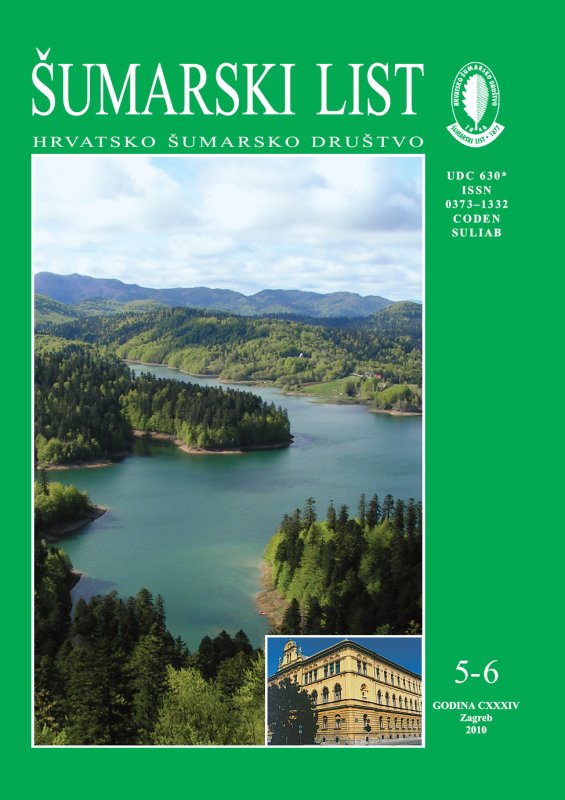
broj: 5-6/2010
pdf (8,5 MB) |
|
||||||||||||||
| RIJEČ GLAVNOGA UREDNIKA | ||
| Branimir Prpić | UDK002090 | |
| ON THE 114th ELECTORAL MEETING OF THE CROATIAN FORESTRYASSOCIATION pdf HR | 209 | |
| IZVORNI ZNANSTVENI ČLANCI | ||
| Vukelić,J., A.Alegro, V.Šegota | UDK 630* 188 (001) | |
| Altimontane-Subalpine Spruce Forest with Laserpitium Krapfii (Laserpitio krapfii-Piceetum abietisass. nova)in Northern Velebit (Croatia) pdf HR EN | 211 | |
| Pernar,N., D. Bakšić, I. Perković, D. Holjević | UDK 630* 116.2 + 114.7 (001) | |
| Impact of Eroded Terrain Recovery on Soil Proporties on Flysch – Case Studies of Abrami and Butoniga in Istria pdf HR EN | 229 | |
| Summary: The impact of biological and technical soil protection measures, as well as the effect of eroded terrain recovery on soil properties, i.e. its regeneration, was investigated in two localities on flysch in Istria. Seven research plots in the erosion research polygon in Abrami were restored for the purpose of measuring annual sediment production by erosion. The condition of soil was investigated in five plots and its regeneration was compared in terms of terrain recovery methods. Two plots were excluded: one because the terrain was completely eroded and turned into bare marl detritus, and another because it was established only recently, therefore, soil properties have not yet been changed by the treatment. Near the village of Grimalda we analyzed the condition of surface soil in the part of the terrain that was afforested in 1982. We made two separate analyses: one in an established black pine stand and the other on abandoned grassland displaying natural progression of forest vegetation. According to our research, the soil in all five plots in the Abrami polygon is equally carbonate, while the pH value shows alkaline reaction. These properties are the consequence of past erosion processes, which have led to predominantly bare, homogeneous, detritus of flysch. As a result, the remaining material has similar properties regardless of the applied recovery methods. Soil in the areas that are not severely eroded is eutric cambisol, while severely eroded slopes are characterized by shallow regosol. Several recovery methods were applied. In the plots restored for the purpose of monitoring sediment production by erosion we analyzed the impact of a) high bench terraces with drywall crowns, b) low and mildly sloping bench terraces, c) classical planting with black pine into holes, d) planting with black pine into bench terraces and undersowing with a grass mixture and Spanish broom, e) planting with black pine into bench terraces without undersowing, and f) areas with varying initial vegetation condition and varying slope degrees. It was found that technical recovery measures had a key role in the reduction of sediment production by erosion, especially in the early stage of the experiment. It was also found that very slow vegetation progression on steep slopes results in very slow soil regeneration. Thus, despite natural colonization with black pine, canopy closure is very slow, while the humus-accumulative soil horizon is poorly developed and fragmented. On milder slopes that are not severely eroded, the undisturbed expansion of natural vegetation (fire protection) produces equal effects on soil properties (and its protection, regeneration, and similar) as does biological recovery with planting black pine. This was confirmed by research in the Grimalda locality. The only difference is slightly higher soil water permeability in the pine culture. The annual sediment production by erosion in the experimental polygon of Abrami partially coincides with the organic matter content. These processes are reversely proportional, which indicates that soil humization and regeneration will be more rapid if erosion prevention is more efficient, or in other words, if better technical and biological recovery measures are applied. Key words: eroded terrain recoveri; forest floor; soil organic matter; soil regeneration | ||
| Pentek,T., H. Nevečerel, K. Dasović,T. Poršinsky, M. Šušnjar, I. Potočnik | UDK 630* 307 + 383 + 377 (001) | |
| Analysis of Secondary Relative Openness in HillyAreas as a Basis for Selection of Winch Rope Length pdf HR EN | 241 | |
| Klobučar, Damir | UDK 630* 629 (001) | |
| Using Geostatistics in Forest Management pdf HR EN | 249 | |
| Redžić,S., S. Barudanović | UDK 630* 189 (001) | |
| Obrasci bioraznolikosti šumske vegetacije Crvanj planine u Hercegovini (zapadni Balkan) pdf HR EN | 261 | |
| PREGLEDNI ČLANCI | ||
| Šporčić,M., M. Landekić, M. Lovrić, S. Bogdan, K. Šegotić | UDK 630* 624 + 568 | |
| Multiple Criteria Decision Making in Forestry – Methods and Experiences pdf HR EN | 275 | |
| Tomljanović,K., M. Grubešić, K. Krapinec | UDK 630* 156 | |
| Testing the Applicability of Digital Camera Sensor for Monitoring Wildlife and other Animal Species pdf HR EN | 287 | |
| KNJIGE I ČASOPISI | ||
| Idžojtić,M., M.Zebec, I.Poljak, J.Medak, B.Tutić | ||
| Following Chestnut Footprints(Castanea spp.) – Cultivation and Culture, Folklore and History, Traditions and Uses PDF | 294 | |


